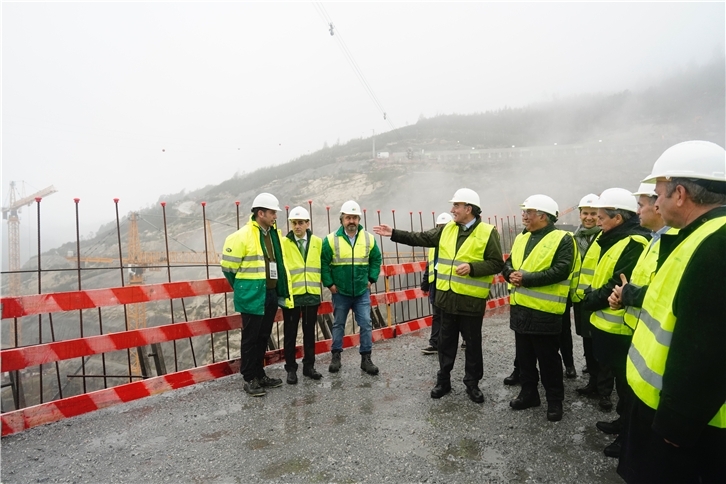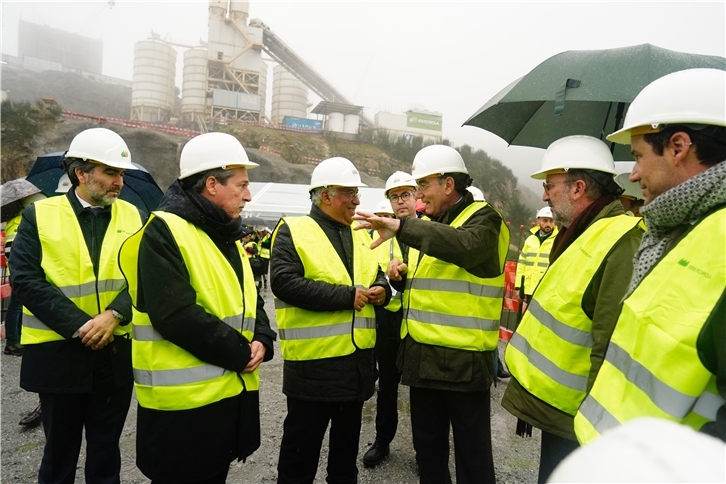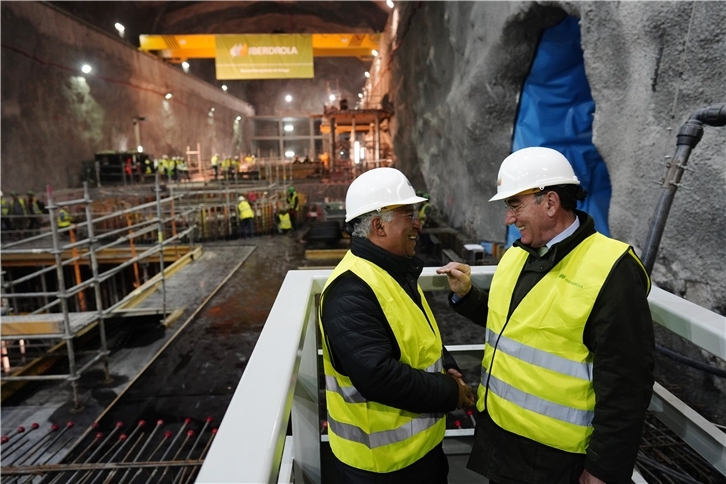News
Its storage capacity is sufficient to serve two million homes for an entire day
Ignacio Galán shows the Portuguese prime minister, António Costa, around the Tâmega giga battery, one of the largest in Europe
- Iberdrola's chairman has indicated that undertaking projects of this magnitude "is possible if there is clear planning, a stable framework, legal certainty and continuous dialogue between the parties", as is the case in Portugal
- With this development, Iberdrola is contributing to the country's progress with its investment of over 1.5 billion euros and the creation of thousands of jobs in over 100 companies, 75 of them Portuguese
- It will help Portugal move towards its emissions reduction targets by increasing the region's wind power capacity: Iberdrola is already promoting other new projects in the area, involving an investment of 200 million euros
Iberdrola's chairman, Ignacio Galán, and the Portuguese prime minister, António Costa, visited the Tâmega giga battery works this morning, one of the largest energy stores in Europe.
The Tâmega complex, with an investment of more than 1.5 billion euros, includes the construction of three reservoirs (Gouvães, Daivões and Alto Tâmega) on the Tâmega river, which is a tributary of the Duero. The works, which began in 2014, are now two thirds completed and are expected to be finalised in 2023 according to the planned schedule, while the Gouvães and Daivões plants will be operational by the end of 2021.
On his visit to the complex — which was also attended by Portugal's minister for the environment and energy transition, João Pedro Matos Fernandes, and the presidents of the town councils in Ribeira de Pena, Vila Pouca de Aguilar, Chaves and Cabeceiras de Basto — Ignacio Galán and António Costa inspected the progress in the works, which employ thousands of professionals from more than 100 companies, 75 of them Portuguese.
Once completed, this large renewable infrastructure will have sufficient storage capacity to serve two million Portuguese households for an entire day and will contribute to the emission reduction targets set by the Portuguese Government.
Iberdrola also launched a socioeconomic action plan for the area around the development more than five years ago, which, with over 50 million euros invested, has promoted social, cultural and environmental initiatives. These are already paying off in the seven municipalities that benefited from the project: Vila Pouca de Aguiar, Riberia de Pena, Boticas, Chaves, Cabeceiras de Basto, Montalegre and Valpaços.
The development of this large complex has been possible thanks to Iberdrola's determined commitment to a sustainable energy model, which began two decades ago, and to the stable environment achieved by Portugal's government in recent years.
Ignacio Galán told António Costa "developing infrastructure such as this (one of the largest in Europe) is only possible if there is clear planning, a stable framework, legal certainty and continuous dialogue to seek solutions to the inevitable incidents that can arise throughout its construction and operation".
Galán also congratulated the Prime Minister on the economic recovery process the country is undergoing: "Based on the incentives provided by the success of its economic programme and the social agenda it has implemented during its term in government, direct foreign investment has increased to record levels".
Commitment to renewable energy in Portugal
The three plants that make up the great Tâmega giga battery (Gouvães, Daivões and Alto Tâmega) add up to 1,158 megawatts (MW).
In addition to the Tâmega project, Iberdrola has other new renewable developments in Portugal: it has recently been awarded the go ahead for new solar capacity to more than double its operational renewable power in the country and is already promoting new wind capacity projects in the Tâmega region, involving an investment of 200 million euros. It will, therefore, be able to supply clean energy to more than 800,000 of the company's Portuguese customers.
This demonstrates Iberdrola's commitment to Portugal and its willingness to continue operating in the country. Thus, at the end of his speech before the prime minister, Ignacio Galán said: "You can be sure that Iberdrola will continue to drive the energy transition in this country, and with it the creation of wealth and well-being for all Portuguese people".
Pumping technology, the most efficient storage
The Tâmega giga battery will provide almost 900 MW of pumping capacity to the Portuguese electricity system, which is an increase of more than 30% compared to the megawatt capacity available to the country today.
The pumping plants currently constitute a safeguard for the electrical system, since they enable energy to be stored by raising water from a lower reservoir to a higher one. This makes it possible to generate a large amount of electricity quickly, by allowing the water to flow down to the lower reservoir via a turbine. And all this takes place with no polluting emissions to the atmosphere.
The excess energy in periods of low consumption is used to pump water from a lower reservoir to a higher one, thus obtaining high-quality energy that can help cover the needs of the market during periods of peak demand.
Hydroelectric pumping technology is key to guaranteeing the electrical system's stability to even out the intermittency of other renewable energy sources such as wind or photovoltaic solar, which are being called on to play a key role in the energy transition that will lead to decarbonising the economy.
Iberdrola expects to reach 90 million kilowatt hours (kWh) of storage capacity by 2022, which is an increase over 2018 of almost 30%: 20 million kWh more, equivalent to 400,000 electric car batteries or 1.4 million batteries for residential use.










